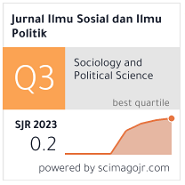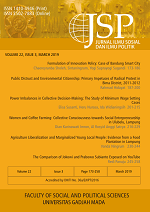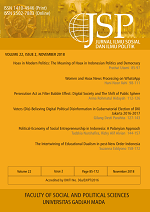Power Imbalances in Collective Decision-Making: The Study of Minimum Wage Setting Cases
Elisa Susanti(1*), Heru Nurasa(2), Ida Widianingsih(3)
(1) Department of Public Administration, Faculty of Social and Political Sciences, Universitas Padjajaran
(2) Department of Public Administration, Faculty of Social and Political Sciences, Universitas Padjajaran
(3) Department of Public Administration, Faculty of Social and Political Sciences, Universitas Padjajaran
(*) Corresponding Author
Abstract
This paper aimed to empirically describe the power imbalances issues in setting the minimum wage in Bandung Regency and West Bandung Regency. Formally, Regional Wage Council has been established based on equality. However, several power imbalances have occurred within it. This paper also aimed to figure out the way to balance the power in collective decision making in the case of minimum wage setting. Furthermore, the research method used in this research was based on qualitative approach. Also, informants in this research were members of Regional Wage Council, employers in the industrial sector, and trade unions/labor unions in Bandung Regency and West Bandung Regency. The results of this study showed that power imbalances empirically existed in the setting of minimum wage. These imbalances were due to the issues of representatives, the number of members, information resources, and uncertainty. Moreover, power imbalances in the setting of minimum wage have led to the government’s more dominant role. Under these conditions, the effort required to overcome the problem of imbalance is by increasing trust in the government and the commitment of each party to the rules and collective agreements.
Keywords
Full Text:
PDFReferences
Ackers, P. (2014). Rethinking the employment relationship: A neo-pluralist critique of British industrial relations orthodoxy. The International Journal of Human Resource Management, 25(18), 2608-2625.
Ansell, C., & Gash, A. (2007). Collaborative governance in theory and practice. Journal of Public Administration Research and Theory, 18, 543–571.
Bandung Regent Decree Number: 561/Kep.182-Disnaker/2015 concerning Appointment of Members of Wage Council and Members of Wage Council Secretariat of Bandung Regency for the 2015-2018.
Budd, J. W., Gomez, R.., & Meltz, N. M. (2004). Why a balance is the best : The pluralist industrial relations paradigm of balancing competing interest. Paper presented at Theoretical Perspectives on Work and the Employment Relationship, Berlin. Retreived from http://jbudd.csom.umn.edu/RESEARCH/buddgomezmeltz.pdf
Buanes, Arild, Jentoft, S., Karlsen, G. K., Maurstad, A., & Søreng, S. (2004). In whose interest? An exploratory analysis of stakeholders in Norwegian coastal zone planning. Ocean & Coastal Management, 47, 207–23.
Caraway, T., & Ford, M. (2017). Institutions and collective action in divided labour movements: Evidence from Indonesia. Journal of Industrial Relations, 59(4), 444- 464.
Choi, T., & Robertson, P. J. (2011). Caucuses in collaborative governance: The effects of structure, power, and problem complexity. International Public Management Journal, 17(2). 224-254.
Clarkson, G., Jacobsen, T., & Batcheller, A. (2007). Information asymmetry and information sharing. Government Information Quarterly, 24, 827–839.
Compston, H. (2009). Policy networks and policy change: Putting policy network theory to the test. New York: Palgrave Macmillan.
Creswell, J. W. (2009). Research design: Qualitative, quantitative, and mixed method approaches. California: Sage.
Faria, J.A., & Silva, S. (2013). The effects of information asymmetry on budget slack: An experimental research. African Journal of Business Management, 7(13), 1086-1099.
Gunton, T. I., & Day, J. C. (2003). The theory and practice of collaborative planning in resource and environmental management. Environments, 31(2), 5–19.
Hayter, S. (2009). A fair globalization: The role of collective bargaining in stemming the rising tide of inequality in earnings and income. International Journal of Labour Research, 1(2)
Hogbin, G. (2006). Power in employment relationships: is there an imbalance?. New Zealand: New Zealand Business Roundtable.
Howlett, M., Mukherjee, I., & Koppenjan, J. (2015). Policy learning and policy networks in theory and practice: The case of Indonesian biodiesel policy network. Paper presented at the PL&PC panel of the ICPP conference, Milan.
Howlett, M., & Ramesh. (1995). Studying public policy: Policy cycles and policy subsystem. New York: Oxford University Press.
Huffman, W. E. (2009). Does information change behavior?. Paper presented at the 3rd OECD World Forum on “Statistics, Knowledge and Policy”. Busan, Korea.
Ibrahim, Z. (2016). Eksistensi serikat pekerja/serikat buruh dalam upaya mensejahterakan pekerja. Jurnal Media Hukum, 23(2)
International Labour Organization (ILO). (2013). National tripartite social dialogue: An ILO guide for improved governance. Geneva: International Labour Organization.
International Labour Organization (ILO). (2008). Global wage report 2008/2009 minimum wages and collectivebargaining: Towards policy coherence. Geneva :International Labour Organization
Kaufman, Bruce E. (2008). Paradigms in industrial relations: Original, modern and versions in-between. British Journal of Industrial Relations, 46(2), 314–339.
Kehinde, A., Ogundeji, M., & Felix, A. (2012). The current status of collective bargaining and its implications on bottom-line performance in Nigeria oil and gas industry. Journal Of Humanities And Social Science, 3(6)
Koppenjan, J., & Klijn, E.H. (2004). Managing uncertainties in networks: A network approach to problem solving and decision making. New York: Routledge
Lamarche, C. (2015). Collective bargaining in developing countries negotiating work rules at the firm level instead of the industry level could lead to productivity gains. Retrieved from IZA World of Labour website: https://wol.iza.org/articles/collective-bargaining-in-developing-countries/long
Lasker, R. D., & Weiss, E. (2003). Broadening participation in community problem-solving: A multidisciplinary model to support collaborative practice and research. Journal of Urban Health, 80, 14–60.
Menteri Tenaga kerja dan Transmigrasi. (2001). Keputusan Menteri Tenaga Kerja dan Transmigrasi Republik Indonesia Nomor Kep-201/MEN/2001 Tentang Keterwakilan dalam Kelembagaan Hubungan Industrial. Jakarta: Menteri Tenaga Kerja dan Transmigrasi Republik Indonesia.
Menteri tenagakerja dan Transmigrasi Republik Indonesia. (2005). Peraturan Menteri Tenaga Kerja dan Transmigrasi Republik Indonesia Nomor: PER.06/MEN/IV/2005 Tentang Pedoman Verifikasi Keanggotaan Serikat Pekerja/ Serikat Buruh. Jakarta: Menteri Tenaga Kerja dan Transmigrasi Republik Indonesia.
Merkhofer, M. W., Conway, R., & Anderson, R. G. (1997). Multiattribute utility analysis as a framework for public participation in siting a hazardous waste management facility. Environmental Management, 21, 831–9.
Murdock, B., Wiessner, C., & Sexton, K. (2005). Stakeholder participation in voluntary environmental agreements: Analysis of 10 project XL case studies. Science, Technology & Human Values, 30, 223–50.
O’Leary, R., Slyke, D. M., & Kim, S. (2010). The future of public administration around the world. Washington D.C : Georgetown University Press.
Ostrom, E.,& Ostrom, V. (1971). Public choice: A different approach to the study of public administration. Public Administration Review, 31(2)
Presiden Republik Indonesia. (2004). Keputusan Presiden Republik Indonesia Nomor 107 Tahun 2004 Tentang Dewan Pengupahan. Jakarta.
President of The Republic of Indonesia. (2015). Government Regulation No. 78 of 2015 concerning Wages. Jakarta: Minister of Law and Human Rights of The Republic of Indonesia.
Provan, K. G., & Kenis, P. (2008). Modes of network governance: Structure, management, and effectiveness. Journal of Public Administration Research and Theory, JPART 18,229–252.
Provan, K. G., & Milward, H. B. (2001). Do networks really work? A framework for evaluating public-sector organizational networks. Public Administration Review, 61(4)
Qu & Loosemore. (2013). A meta-analysis of opportunistic behaviour in public-private partnerships: Manifestations and antecedents. In Smith, S.D and Ahiaga-Dagbui, D.D (Eds.), Proceeding 29 th Annual ARCOM Conference (pp. 415-424). UK.
Rogers, Todd, Howard-Pitney, B., Feighery E. C., Altman, D. G., Endres, J. M., & Roeseler, A. G. (1993). Characteristics and participant perceptions of tobacco control coalitions in California. Health Education Research, Theory & Practice, 8, 345–57.
Taufiq, M., & Hidayat, Z. (2011). Kajian hukum terhadap perselisihan pemutusan hubungan kerja secara sepihak pada perusahaan. Jurnal WIGA, 2(2)
The President of The Republic of Indonesia. (2003). Law Number 13/2003 concerning Manpower. Jakarta.
Utami, T. K. (2013). Peran serikat pekerja dalam penyelesaian pemutusan hubungan kerja. Jurnal Wawasan Hukum, 28(1)
Wanna, J., & O’Flynn, J. (2008). Collaborative governance : A new era of public policy in Australia. Australia : The Australian National University.
Bupati Bandung Barat. (2016). West Bandung Regent Decree No. 560/Kep.462- insoskertrans/2016 concerning the Formation of Wage Council and Wage Council Secretariat of West Bandung Regency for 2014-2017. Bandung Barat.
Yaffee, S. L., & Julia W. (2003). Collaborative ecosystem planning processes in the United States: Evolution and challenges. Environments, 31(2), 59–72.
Article Metrics
Refbacks
- There are currently no refbacks.
Copyright (c) 2019 Jurnal Ilmu Sosial dan Ilmu Politik

This work is licensed under a Creative Commons Attribution-NonCommercial-NoDerivatives 4.0 International License.






















